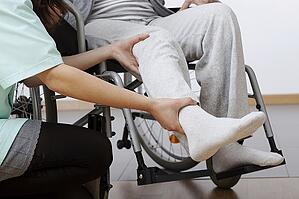The Benefits of Senior Physical Therapy Programs
Anneliese Peterson | Feb 24, 2015
Leading an active lifestyle is important for individuals of all ages. As a parent, you undoubtedly encourage your children to run, jump, and play outside with their friends. The activity helps them maintain a healthy weight, tones muscles, improves heart and lung functions, and offers a great opportunity to socialize with others. But what about your parents? Remaining physically active as you age can have a positive impact on their quality of life.
Older adults reap the same benefits from physical activity that your children do. If you’re worried about their ability to sustain physical activity, you should know that there are options to help them. Senior physical therapy programs offer seniors a chance to improve their quality of life in a number of ways.
What is Physical Therapy?
 Senior physical therapy programs are designed to meet a variety of needs in older adults. Physical therapy programs are great for seniors recovering from an injury or illness, those experiencing chronic pain, and even those looking to restore physical functions such as flexibility, strength, balance, and coordination.
Senior physical therapy programs are designed to meet a variety of needs in older adults. Physical therapy programs are great for seniors recovering from an injury or illness, those experiencing chronic pain, and even those looking to restore physical functions such as flexibility, strength, balance, and coordination.
A senior physical therapy regimen combines a variety of approaches to improve an older adult’s ability to perform simple daily tasks and activities. Physical therapy combines activities such as stretching, walking massage, hydrotherapy, and electrical stimulation to help seniors regain strength, improve their balance, and relief stress and pain associated with chronic conditions.
Benefits of Senior Physical Therapy
There are a number of benefits involved in senior physical therapy. For those older adults simply looking to improve their quality of life, a physical therapy regimen provides the following physical and mental health benefits:
- Maintain healthy weight: Metabolism rates slow with age. Exercise can help boost metabolism and aid the body in maintaining a healthy weight.
- Reduce impact of illness/disease: Exercise can improve immune function, heart health, blood pressure, and boost digestive function.
- Improve mobility: By improving strength, flexibility, and posture, seniors enjoy better balance and coordination. This helps reduce the risk of falls.
- Improve sleep: A good exercise regimen helps seniors fall asleep easier and sleep more deeply.
- Boost to self-confidence: Endorphins released during exercise improve a senior’s mood, reducing feelings of sadness or depression in the process. Leading an active lifestyle also boosts an individual’s self-confidence.
Senior physical therapy programs can improve the daily quality of life older adults enjoy, and it can also help reduce the impact of numerous diseases and chronic illnesses. There are far too many to cover here, but among the more common conditions treated with physical therapy are arthritis, stroke, and Alzheimer’s.
According to the Centers for Disease Control (CDC), 49.7% of seniors over 65 report doctor-diagnosed arthritis of one kind or another. Physical therapy can help older adults manage arthritis pain through aquatic exercise (low-impact movement), hot packs, and electrical stimulation.
Senior physical therapy can aid older adults on the road to recovery from a stroke. Through the use of constraint-induced movement therapy, which restrains good limbs and focuses on the weaker hand or arm, seniors work to regain function following a stroke. Motor imagery and mental practice help seniors rehearse certain movements, stimulating the part of the brain that controls those movements and regaining function.
Physical therapy has even been shown to help those suffering from Alzheimer’s by delaying the onset of serious memory issues. A technique known as mirroring shows patients how to safely perform physical movements by mirroring the movements of a physical therapist. Techniques such as dance help older adults remember certain types of movement, boosting memory retention.
Finding Physical Therapy Programs
As you explore your options and work to find a suitable physical therapy program, speak with physicians is a good starting point. As their primary doctor, an older adult’s physician is keenly aware of their current health status and physical capabilities. When it comes to selecting a specific physical therapy program, keep current physical fitness level and mental health status in mind.
Therapy programs can be conducted in an adult’s home, under the guidance of a physical therapist, for those looking to improve their quality of life or seeking relief from chronic pain. Older adults who are in poor health, suffering from advanced illnesses, or recovering from a stroke (or other health incident) may require a program offered through a hospital, assisted living community, senior living community, or memory care residence.
